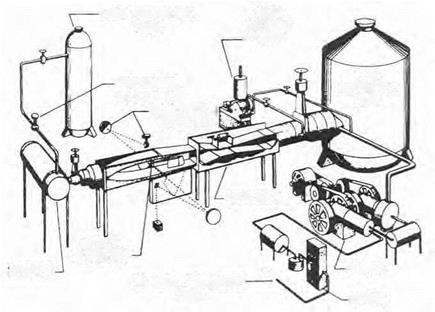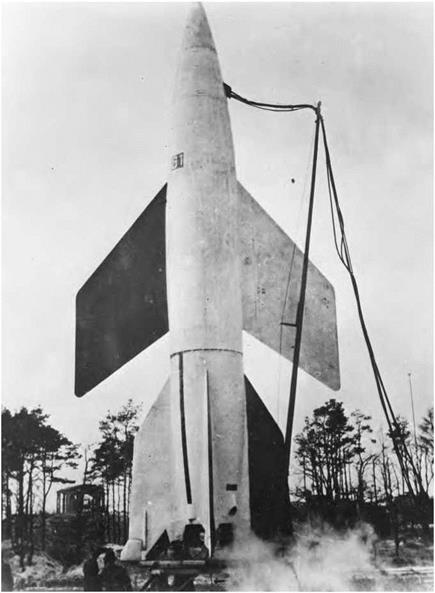Moving Beyond the V-2: John Becker Births American Hypersonics
During the Second World War, Germany held global leadership in highspeed aerodynamics. The most impressive expression of its technical interest and competence in high-speed aircraft and missile design was the V-2 terror weapon, which introduced the age of the long-range rocket. It had a range of over 200 miles at a speed of approximately Mach 5.[547] A longer-range experimental variant tested in 1945, the A-4b, sported swept wings and flew at 2,700 mph, reentering and leveling off in the upper atmosphere for a supersonic glide to its target. In its one semisuccessful flight, it completed a launch and reentry, though one wing broke off during its terminal Mach 4+ glide.[548] One appreciates the ambitious nature and technical magnitude of the German achievement given that the far wealthier and more technically advantaged United States pursued a vigorous program in piloted rocket planes all through the 1950s without matching the basic performance sought with the A-4b.
Key to the German success was a strong academic-industry partnership and, particularly, a highly advanced complex of supersonic wind tunnels. The noted tunnel designer Carl Wieselsberger (who died of cancer during the war) introduced a blow-down design that initially operated at Mach 3.3 and later reached Mach 4.4. The latter instrument supported supersonic aerodynamic and dynamic stability studies of various craft, including the A-4b. German researchers had ambitious plans for even more advanced tunnels, including an Alpine complex capable of attaining Mach 10. This tunnel work inspired American emulation after the war and, in particular, stimulated establishment of the Air Force’s Arnold Engineering Development Center at Tullahoma, TN.[549]
|
The German A-4b, being readied for a test flight, January 1945. USAF. |
At war’s end, America had nothing comparable to the investment Germany had made in high-speed flight, either in rockets or in wind tunnels and other specialized research facilities. The best American wartime tunnel only reached Mach 2.5. As a stopgap, the Navy seized a German facility, transported it to the United States, and ran it at Mach 5.18, but
|
|
||
|
|||
 |
|||


DIFFUSER
The layout of the Langley 11-inch hypersonic tunnel advocated by John V. Becker. NASA.
it did this only beginning in 1948.[550] Even so, aerodynamicist John Becker, a young and gifted engineer working at the National Advisory Committee for Aeronautics (NACA) Langley Laboratory, took the initiative in introducing Agency research in hypersonics. He used the V-2 as his rationale. In an August 1945 memo to Langley’s chief of research, written 3 days before the United States atom-bombed Hiroshima, he noted that planned NACA facilities were to reach no higher than Mach 3. With the V-2 having already flown at Mach 5, he declared, this capability was clearly inadequate.
He outlined an alternative design concept for "a supersonic tunnel having a test section four-foot square and a maximum test Mach number of 7.0.”[551] A preliminary estimate indicated a cost of $350,000. This was no mean sum. It was equivalent six decades later to approximately $4.2 million. Becker sweetened his proposal’s appeal by suggesting that Langley
begin modestly with a small demonstration wind tunnel. It could be built for roughly one-tenth of this sum and would operate in the blow-down mode, passing flow through a 1-foot-square test section. If it proved successful and useful, a larger tunnel could follow. His reasoned idea received approval from the NACA’s Washington office later in 1945, and out of this emerged the Langley 11-Inch Hypersonic Tunnel. Slightly later, Alfred J. Eggers began designing a hypersonic tunnel at the NACAs West Coast Ames Aeronautical Laboratory, though this tunnel, with a 10-inch by 14-inch test section, used continuous, not blow-down, flow. Langley’s was first. When the 11-inch tunnel first demonstrated successful operation (to Mach 6.9) on November 26, 1947, American aeronautical science entered the hypersonic era. This was slightly over a month after Air Force test pilot Capt. Charles E. Yeager first flew faster than sound in the Bell XS-1 rocket plane.[552]
Though ostensibly a simple demonstration model for a larger tunnel, the 11-inch tunnel itself became an important training and research tool that served to study a wide range of topics, including nozzle development and hypersonic flow visualization. It made practical contributions to aircraft development as well. Research with the 11-inch tunnel led to a key discovery incorporated on the X-15, namely that a wedgeshaped vertical tail markedly increased directional stability, eliminating the need for very large stabilizing surfaces. So useful was it that it remained in service until 1973, staying active even with a successor, the larger Continuous Flow Hypersonic Tunnel (CFHT), which entered service in 1962. The CFHT had a 31-inch test section and reached Mach 10 but took a long time to become operational. Even after entering service, it operated much of the time in a blow-down mode rather than in continuous flow.[553]











